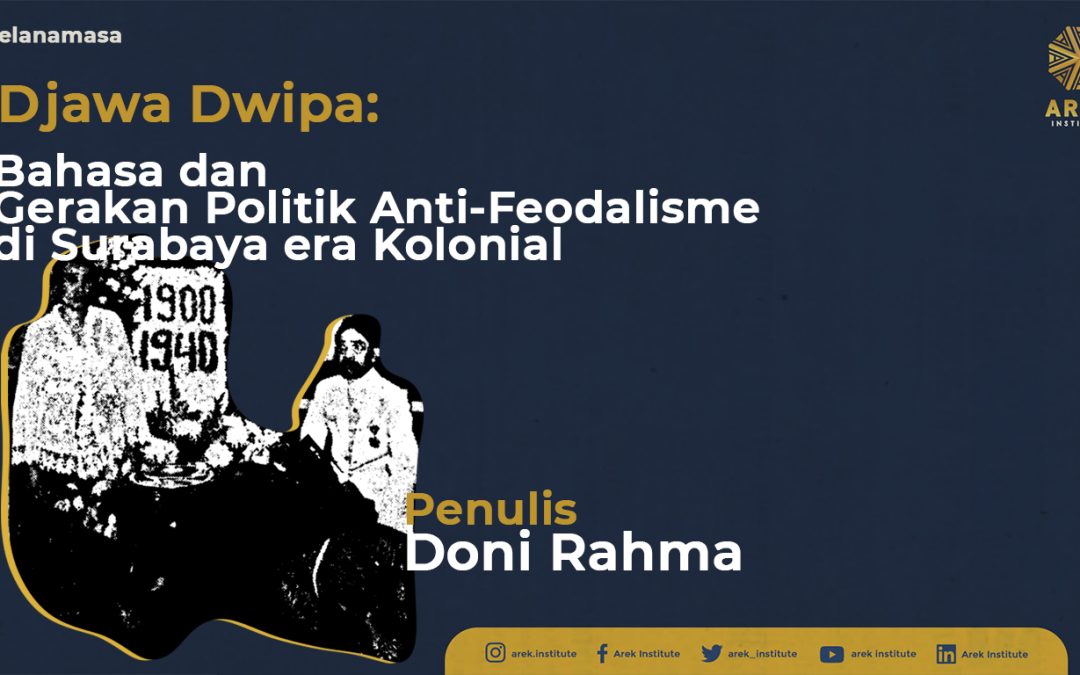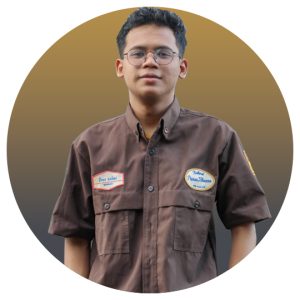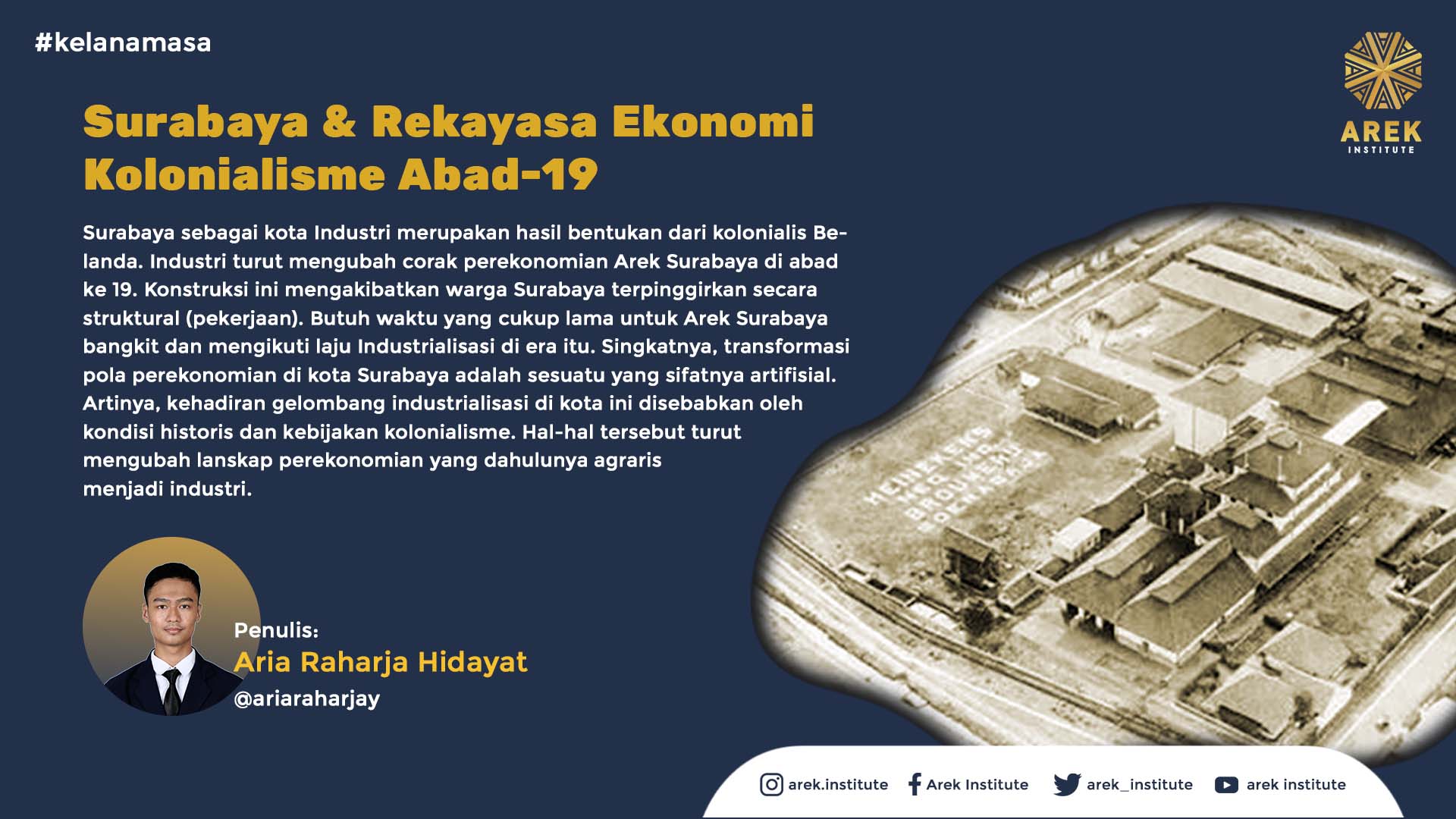
Djawa Dipa: Language and Anti-Feodal Political Movement in Surabaya Colonial Period Doni Rahma Raga Pratama

Doni Rahma | Anthropology FISIP Unair Student | Arek Institute Researcher Network
Almost 100 years ago, on March 11, 1917, in Surabaya, a movement called Djawa Dipa was born, opposing the feudalistic practices of the time. According to various records, the movement was first initiated in two locations: the Oost Java Bioscoop building (now a shopping complex in the Aloon-aloon Contong area) and the Oost JavaRestaurant. From its inception, Djawa Dipa aimed to equalize the use of the Javanese language by abolishing its hierarchical structure. In other words, unggah-ungguhing basa (the stratified levels of Javanese language such as ngokoand krama) had to be eliminated. The Krama class, referring to the lower layers of Javanese society, became the movement’s main focus because equality for them was of utmost importance. Until then, the hierarchy in the use of the Javanese language had only widened the gap of social stratification and reinforced unfair treatment against them (Thamrin, 2022).
One of the key figures behind the birth of Djawa Dipa was Tjokrosoedarmo, the leader of the SI (Sarekat Islam) Surabaya branch — a native arek Suroboyo from the Plampitan neighborhood, who came from a priyayi (noble) family background. However, in contrast to his aristocratic origins, he became a vocal critic of the rules governing the use of krama (high-level Javanese language). For him, a language structure built on rigid hierarchy was not a tool for communication, but rather a wall of oppression — something that burdened the Javanese people. This was evident in a fragment of his radical ideas, delivered during a speech at the formation of the Djawa Dipa committee, which was also published in the Sinar Djawa newspaper, March 15, 1917 edition.
”…telah njata kita ketahoei, sampai saat ini, dan sampai zaman perobahan ini, atoeran bahasa Djawa ”kromo” itoe hanjalah membikin soesah kita Djawa sadja. Berlantaran atoeran bahasa Djawa ”Kromo” itoe tidak sedikit bilangannya…Maka ketjelakaan dan kesengsaraan pendjara itoe bagi kita boekan bangsa ”sastrawan” hanjalah lantaran soesahnja atoeran bahasa Djawa ”kromo” ada di moeka persidangan hakim”
(…it is clear to us, even up to this moment, and into this era of change, that the rules of the Javanese ‘krama’ language only bring hardship to us Javanese. Because of these ‘krama’ language rules—of which there are no small number… Misfortune and the suffering of imprisonment for us, who are not a ‘literary’ people, are merely caused by the difficulty of these ‘krama’ rules when faced in front of the judge’s court.)
In its time, Djawa Dipa appeared to be supported by prominent figures, including Tjokroaminoto of Sarekat Islam itself. Although Tjokroaminoto was initially not very enthusiastic about the emergence of Djawa Dipa, as the movement gradually expanded in 1918 and his dominance within Sarekat Islam (CSI) began to wane, he quickly moved to consolidate new forces. Djawa Dipa was then promoted and pushed to become a militant movement aimed at transforming the “slave mentality” of the Javanese people (Siraishi, 1997).
As a movement, Djawa Dipa often directly issued appeals encouraging the reduction of krama (high-level Javanese) usage. One of its early recommendations included changing honorifics or forms of address: using “Wiro” for men, “Woro” for married women, and “Liro” for unmarried women (Thamrin, 2022). The movement also expanded to include calls for rejecting long-standing gestures of deference embedded within the Dutch East Indies bureaucracy. These gestures included a wide range of social behaviors, dress codes, hierarchical language use, and honorary titles.
Javanese people were required to treat Dutch officials with elaborate forms of submission: walking in a crouched or squatting position (jongkok), addressing colonial officers as kanjeng tuan, sitting cross-legged in their presence, and performing a respectful gesture of placing both hands against the upper lip (sembah) after the officials spoke (Der Meer, 2021).
Although Djawa Dipa was enthusiastically welcomed by the Javanese public and became a topic of discussion in various newspapers at the time, its presence also brought with it the consequence of skepticism about its effectiveness in leveling the Javanese language. This view emerged from the conservative elite, who felt that their power was being threatened by the rise of Djawa Dipa. This sentiment was evident, for instance, in a column published in De Indier on April 10, 1917. The author of the piece was not clearly identified, but the tone of the writing revealed a skeptical attitude toward the presence and aims of Djawa Dipa.
”De ngoko-questie houdt de gemoederen in de inlandsche wereld nog warm. Er is bereids een vereeniging gevormd onder den naam Djawa Dipa, die het ngoko zal trachten vereheffen tot algemeene tal op Java. Wij staan er zeer sceptisch tegenover!”
(The ngoko question continues to stir emotions in the inlander. An association has already been formed under the name Djawa Dipa, which will attempt to elevate ngoko to the status of a general language in Java. We view this with great skepticism!)
There was also a lengthy opinion piece titled “Djowo Dipo Contra Adat” (“Djawa Dipa Against Custom”) written by a district head (the specific region was not detailed), published in the De Locomotief newspaper on June 14, 1921. In it, he expressed his concerns about the growing presence of Djawa Dipa, which he viewed as increasingly troubling.
According to him, the Djawa Dipa movement was seen as undermining the authority of the priyayi (Javanese aristocracy). This colonial official considered the use of informal terms like “Kowe” (you, in low-register Javanese) when addressing officials to be an insult to the established customs and power structures.
Although he did not deny that real change was happening, he insisted that politeness must remain paramount. He cited an incident in which a wedana (district head) was approached by two members of Djawa Dipa as an example of this perceived breach of decorum.
”…De wedono liet zich niettemin door die woorden niet van streek brengen, bleef kalm en vroeg den heeren gemoedelijk in het hoog-Javaansch: ‘Sampean wonten perloe poenopo?’ (Wat is er van uw dienst?”
(…The wedana, however, was not shaken by those words, remained calm, and politely asked the gentlemen in high Javanese: ‘Sampean wonten perloe poenopo?’What can I do for you?’)
Despite all of that, Djawa Dipa chose to remain actively vocal. To facilitate the wider dissemination of their propaganda, in April 1921 they finally launched the first issue of their weekly newspaper titled Hindia Dipa (Thamrin, 2022).
The release of the newspaper appears to have been accelerated compared to the original plan. This differed from a report in the Nieuwe Rotterdamsche Courant dated March 22, 1921, which had stated that Hindia Dipa would be published at the end of 1921.
On the other hand, Hindia Dipa, as the media outlet of Djawa Dipa, chose to use a blend of Malay-Javanese as its primary language.
Language as a revolutionary medium
During the 19th century, the Dutch systematically indoctrinated themselves into Javanese society through a process of cultural appropriation that legitimized their authority. This legitimacy was heavily dependent on the preservation of the culture of the traditional elite. The Dutch deliberately created cultural hegemony by adopting and institutionalizing Javanese-style rituals. Symbols of power—such as hierarchical forms of dress, lifestyle, language, consumption, and architecture—were carefully maintained and reinforced by the colonial regime (Der Meer, 2019).
Clifford Geertz, in his book Negara: The Theatre State in Nineteenth-Century Bali, also explained that state power is not only embodied in institutions but also in the continuous production of symbols. In other words, symbols are not merely matters of aesthetics—they are manifestations of power itself.
All of this gradually began to shift. The early 20th century marked a transformative period of social and cultural change. The Dutch Ethical Policy, though intended as a colonial reform, inadvertently created the conditions for the emergence of indigenous movements that became increasingly critical of all forms of feudal relations with the colonial power (Der Meer, 2021).
It was within this context that history records the rise of a radical movement in Surabaya that opposed state domination—particularly as it related to language hierarchy. As noted by J. P. Zurcher, although traditional customs were still respected, the times had changed significantly. The Javanese people of the past were no longer the same as those of the present. They had evolved, and with that evolution came a naturally emerging spirit of resistance.
DAFTAR PUSTAKA
Der Meer, A. (2019). Igniting Change in Colonial Indonesia: Soemarsono’s Contestation of Colonial Hegemony in a Global Context. Journal of World History, 30(4), 501–532.
Der Meer, A. (2021). Sweet Was the Dream, Bitter the Awakening: The Contested Implementation of the Ethical Policy 1901-1913. In Performing Power: Cultural Hegemony, Identity, and Resistance in Colonial Indonesia (pp. 48–76). Cornell University Press.
Districtshoofd. (1921, June 14). Djawa Dipa Contra Adat. De Locomotief.
Djawa Dipa. (1917, April 10). De Indier.
Geertz, C. (2017). Negara Teater: Kerajaan-Kerajaan di Bali Abad Kesembilan Belas. BasaBasi.
Java en Madoera. (1921, March 22). Nieuwe Rotterdamsche Courant .
Siraishi, T. (1997). Zaman Bergerak: Radikalisme Rakyat di Jawa 1912-1926. Pustaka Utama Grafiti.
Thamrin, M. H. (2022). Djawa Dipa: Sama Rata, Sama Rasa, Sama Bahasa 1917-1922 (1st ed.). Komunitas Bambu.
Zurcher, P. J. (1920). De Indische Gids (Vol. 42). J. H. de Bussy.






